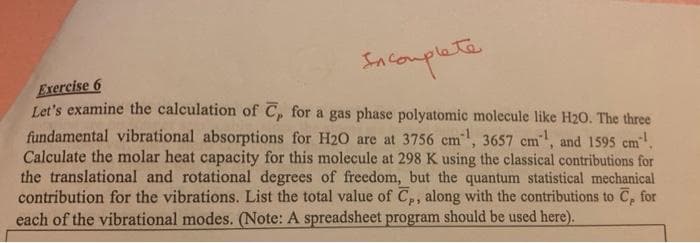Let's examine the calculation of C, for a gas phase polyatomic molecule like H2O. The three fundamental vibrational absorptions for H20 are at 3756 cm', 3657 cm, and 1595 cm. Calculate the molar heat capacity for this molecule at 298 K using the classical contributions for the translational and rotational degrees of freedom, but the quantum statistical mechanical contribution for the vibrations. List the total value of C,, along with the contributions to C, for
Let's examine the calculation of C, for a gas phase polyatomic molecule like H2O. The three fundamental vibrational absorptions for H20 are at 3756 cm', 3657 cm, and 1595 cm. Calculate the molar heat capacity for this molecule at 298 K using the classical contributions for the translational and rotational degrees of freedom, but the quantum statistical mechanical contribution for the vibrations. List the total value of C,, along with the contributions to C, for
Physical Chemistry
2nd Edition
ISBN:9781133958437
Author:Ball, David W. (david Warren), BAER, Tomas
Publisher:Ball, David W. (david Warren), BAER, Tomas
Chapter18: More Statistical Thermodynamics
Section: Chapter Questions
Problem 18.4E
Related questions
Question

Transcribed Image Text:Sntomplete
Exercise 6
Let's examine the calculation of C, for a gas phase polyatomic molecule like H20. The three
fundamental vibrational absorptions for H20 are at 3756 cm, 3657 cm, and 1595 cm.
Calculate the molar heat capacity for this molecule at 298 K using the classical contributions for
the translational and rotational degrees of freedom, but the quantum statistical mechanical
contribution for the vibrations. List the total value of C,, along with the contributions to C, for
each of the vibrational modes. (Note: A spreadsheet program should be used here).
Expert Solution
This question has been solved!
Explore an expertly crafted, step-by-step solution for a thorough understanding of key concepts.
Step by step
Solved in 4 steps with 4 images

Knowledge Booster
Learn more about
Need a deep-dive on the concept behind this application? Look no further. Learn more about this topic, chemistry and related others by exploring similar questions and additional content below.Recommended textbooks for you

Physical Chemistry
Chemistry
ISBN:
9781133958437
Author:
Ball, David W. (david Warren), BAER, Tomas
Publisher:
Wadsworth Cengage Learning,

Principles of Modern Chemistry
Chemistry
ISBN:
9781305079113
Author:
David W. Oxtoby, H. Pat Gillis, Laurie J. Butler
Publisher:
Cengage Learning

Physical Chemistry
Chemistry
ISBN:
9781133958437
Author:
Ball, David W. (david Warren), BAER, Tomas
Publisher:
Wadsworth Cengage Learning,

Principles of Modern Chemistry
Chemistry
ISBN:
9781305079113
Author:
David W. Oxtoby, H. Pat Gillis, Laurie J. Butler
Publisher:
Cengage Learning